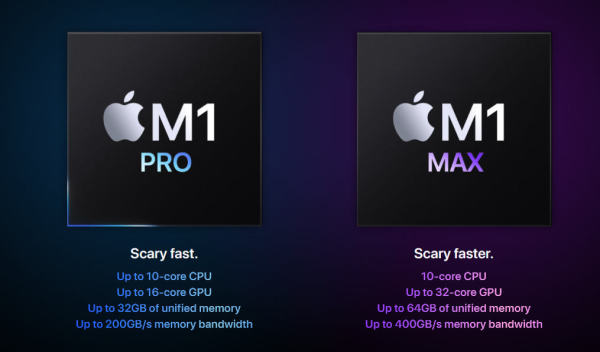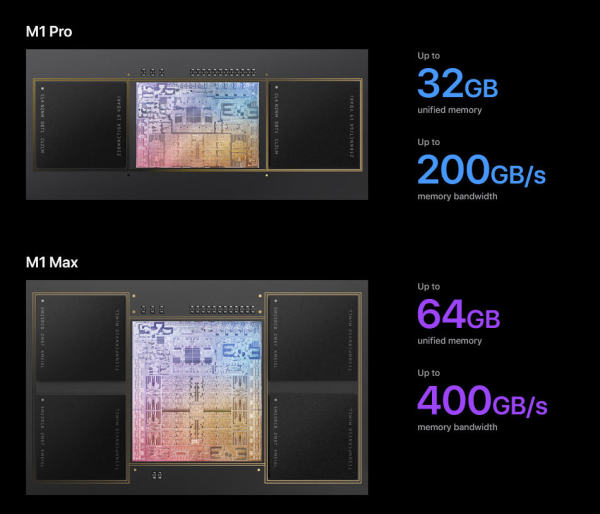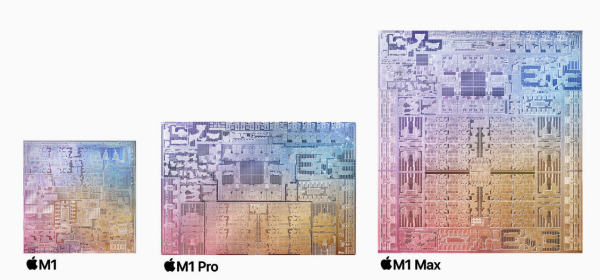[21:54 Mon,18.October 2021 by Thomas Richter] |
Apple has surpassed  Apple M1 Pro and M1 Max. Apple M1 Pro and M1 Max.The two new Apple M1 Pro and M1 Max SoCs (system-on-a-chip), manufactured in 5 nanometer technology, both feature CPUs with (depending on the configuration) up to 10 cores (M1: maximum 8) and - unchanged compared to the M1 - a Neural Engine with 16 cores. However, they differ in the number of GPU cores (the M1 Pro has up to 16, the M1 Max up to 32, the M1 only a maximum of 8), the maximum memory (M1 Pro: up to 32 GB, M1 Max up to 64 GB - for comparison: the M1 could be equipped with a maximum of 16 GB) as well as the memory bandwidth (M1 Pro 200 GB/s, M1 Max up to 400 GB/s - for comparison: M1 had 68.25GB/s). The GPU in the M1 Pro is up to 2 times faster than the M1, while the GPU in the M1 Max is up to 4 times faster than the M1. The unified memory architecture, i.e. the fact that CPU, GPU and other components like the neural engine and encoder/decoder share the memory via an extremely fast connection, opens up new possibilities for the GPU with so much memory, which can thus access a large part of the up to 64 GB RAM - for comparison: the mobile GPUs of PC laptops have a maximum of 16 GB VRAM.  Apple M1 Pro and M1 Max In addition, Apple benefits from the extremely high integration density (as well as the 5 nanometer technology) of all important components on one chip, as already with the M1 SoC (and the related AX Bionic SoCs of the iPhones and iPads) from their energy savings compared to traditional systems. For example, according to Apple, the M1 Pro&s GPU consumes 70% less power at the same maximum performance as a mobile GPU and also 70% less power at 1.7x higher performance than an 8-core laptop PC. According to Apple, the M1 Max&s GPU delivers performance comparable to that of a high-end GPU in a compact Pro PC notebook while consuming 40 percent less power on average. Compared to the M1, the M1 Max is said to be 13 times faster when rendering complex timelines in Final Cut Pro, for example.  Apple M1, M1 Pro and M1 Max compared. New media engine with native ProRes encoding/decoding support.Both the M1 Pro and M1 Max feature an Apple-developed Media Engine with special acceleration for working with the professional ProRes video codec, which speeds up video processing while maximizing battery life. This allows the M1 to play multiple streams of high-quality 4K and 8K ProRes video with low power consumption, and the M1 Max to compress ProRes video up to 2 times faster compared to the M1 Pro using its dual ProRes accelerators. Compared to the previous generation 16-inch MacBook Pro, the MacBook Pro with M1 Max can transcode ProRes video into Compressor up to 10 times faster.  More external displays via Apple M1 Max. More enhancements.The new M1 Pro as well as the M1 Max chips bring even more improvements - so now by means of the new display engine finally several external displays can be addressed - in contrast to originally only one native one with the M1. Thus, up to three 6K as well as one 6K monitor can be natively connected via the M1 Max without additional adapters. Furthermore, additional integrated Thunderbolt 4 controllers provide even more I/O bandwidth. deutsche Version dieser Seite: Apple M1 Pro / Max Chips in neuen MacBook Pros - bis zu 4x schneller als M1 |





